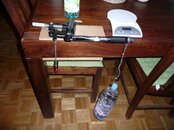Zung
Contributor
After reading all the horror stories here about over-torqued bolt, I decided its time to invest, so I got 2 torque wrenches off eBay, for $20 each: a 2-20 Nm (20-200 in-lbs) for the swivel bolt, and a 10-100 Nm (5-80 ft-lbs) for the yoke.
Now how trustworthy are they for 20 bucks? At least one member reported he beheaded a MK5 with a brand new torque wrench
I decided they need a calibration, at least a check before use, and the Internet provides: no need for any fancy and expensive machinery, just clamp the square drive, and hang some known weight off the handle until it clicks, and read the torque.
If L is the distance between the center of the square drive and where you hang the weight,
W is the weight of the weight, and
T is the resulting torque, then
T = L x W
In whatever unit you please, as long as its consistent.
Procedure: calculate the torque, set the wrench where it should be, put the weight on; if it clicks, try a bit more, if it doesnt, back out a bit. Ease the weight up every time you adjust.
This gentleman improved upon the above with an intriguing idea I call self-torque: the weight of the wrench itself contributes to the torque. To derive this value, he proposed to weight the wrench and find its center of gravity by balancing it on your finger, and the self-torque is the weight of the wrench times the distance from the square drive to the center of gravity.
So now if L2 is the distance to the center of gravity and W2 the weight of the wrench:
T = (L x W) + (L2 x W2)
Now its time to do some preliminary calibrations; I took my wrenches to 2 different supermarkets and weighted them. Heres what I got:
Small wrench:
Supermarket 1: 0.608 Kg
Supermarket 2: 0.608 Kg
My $15 digital kitchen scale: 0.610 Kg (+0.33%)
The center of gravity is approx. 0.143 m, so the self-torque is 0.85 Nm, far from negligible at the lower end of the range. But the accuracy of the measurement of the cg is negligible.
On to the calibration, using combinations of bottles of water carefully weighted with my now calibrated scale. Results are given in in-lbs:
Read: 31.8, actual: 35.9, error: +11.5%
Read: 49, actual: 45.6, error: -7.5%
Read: 78.8, actual: 73.9, error: -6.6%
Read: 93.5, actual: 90.9, error: -2.8%
Not perfect, but what do you expect for 20 bucks? Most importantly, the 1st value above will let me deal with the brass bolt, and the 3rd the stainless steel bolt, and thats what I bought the wrench for.
Im still trying to figure out the weights to deal with the big wrench. Ill report back when Im there.
Now how trustworthy are they for 20 bucks? At least one member reported he beheaded a MK5 with a brand new torque wrench
I decided they need a calibration, at least a check before use, and the Internet provides: no need for any fancy and expensive machinery, just clamp the square drive, and hang some known weight off the handle until it clicks, and read the torque.
If L is the distance between the center of the square drive and where you hang the weight,
W is the weight of the weight, and
T is the resulting torque, then
T = L x W
In whatever unit you please, as long as its consistent.
Procedure: calculate the torque, set the wrench where it should be, put the weight on; if it clicks, try a bit more, if it doesnt, back out a bit. Ease the weight up every time you adjust.
This gentleman improved upon the above with an intriguing idea I call self-torque: the weight of the wrench itself contributes to the torque. To derive this value, he proposed to weight the wrench and find its center of gravity by balancing it on your finger, and the self-torque is the weight of the wrench times the distance from the square drive to the center of gravity.
So now if L2 is the distance to the center of gravity and W2 the weight of the wrench:
T = (L x W) + (L2 x W2)
Now its time to do some preliminary calibrations; I took my wrenches to 2 different supermarkets and weighted them. Heres what I got:
Small wrench:
Supermarket 1: 0.608 Kg
Supermarket 2: 0.608 Kg
My $15 digital kitchen scale: 0.610 Kg (+0.33%)
The center of gravity is approx. 0.143 m, so the self-torque is 0.85 Nm, far from negligible at the lower end of the range. But the accuracy of the measurement of the cg is negligible.
On to the calibration, using combinations of bottles of water carefully weighted with my now calibrated scale. Results are given in in-lbs:
Read: 31.8, actual: 35.9, error: +11.5%
Read: 49, actual: 45.6, error: -7.5%
Read: 78.8, actual: 73.9, error: -6.6%
Read: 93.5, actual: 90.9, error: -2.8%
Not perfect, but what do you expect for 20 bucks? Most importantly, the 1st value above will let me deal with the brass bolt, and the 3rd the stainless steel bolt, and thats what I bought the wrench for.
Im still trying to figure out the weights to deal with the big wrench. Ill report back when Im there.





